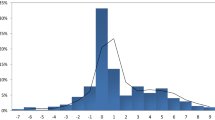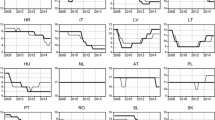Abstract
We investigate the effect of sovereign credit ratings on bank credit ratings, known as the sovereign effect. Our study differs from the literature in three respects. First, we examine whether bank ratings below, at, or above the sovereign ceiling impact the sovereign effect. We find that the sovereign effect holds in all cases. Next, we consider the asymmetric impact of the sovereign effect on bank ratings with or without the ceiling effect. We find that a downgrade exhibits a stronger sovereign effect than an upgrade. Third, we examine whether the asset deterioration or the stable foreign fund hypotheses are possible explanations for the sovereign effect. Our results support both hypotheses.
Similar content being viewed by others
Notes
National Bank of Egypt, Banque Misr, Banque du Caire, Commercial International Bank, and Bank of Alexandria.
Of the 38 companies, 28 were Latin American and 29 were in banking and finance.
They likewise use the firms’ credit ratings to proxy for the firms’ cost of debt.
Han et al. (2013), Poon and Firth (2005), Poon et al. (1999), Poon et al. (2009), and Roy (2013) investigate whether there is a difference between solicited and unsolicited ratings. Iannotta (2006) Rojas-Suarez (2001), Shen and Huang (2013), and Shen et al. (2012) investigate the determinants of bank credit ratings. Bongini et al. (2002), Poghosyan and Čihák (2011), and Wheelock and Wilson (2000) investigate the determinants of bank failures.
Because not all banks provide this information, the number of sample banks is reduced when we include this variable in our model. The number of banks is reduced from 4,561 to 1,692 when using the S&P rating data, and from 5,752 to 1,882 when using the Fitch data.
In his testimony before The Financial Crisis Inquiry Commission on April 7, 2010, former Chairman of the Federal Reserve Alan Greenspan identified the global proliferation of securitized U.S. subprime mortgages as the immediate trigger of the 2008 financial crisis.
To control for the influence of the crisis, exclude 2008 because it is the hectic period of the subprime crisis in which many countries and banks were downgraded owing to the crisis.
However, our sample periods are shortened when considering the CDS because most country CDS data began in 2004. Moreover, the CDS data are available for only half of the countries in Bloomberg. The sample countries are reduced when the models’ consider the CDS. Similar data problems occur in the government bond spread because most emerging countries do not issue bonds on a regular basis. The sample countries are reduced when the models’ consider this spread.
References
Acharya VV, Rajan RG (2013) Sovereign debt, government myopia, and the financial sector. Rev Financ Stud 26:1526–1560
Ahmed A, Billing B, Morton R, Stanford-Harris M (2002) The role of accounting conservatism in mitigating bondholder-shareholder conflicts over dividend policy and in reducing cost of debts. Acc Rev 77:867–890
Aizenman J Binici M, Hutchison MM (2013) Credit ratings and the pricing of sovereign debt during the Euro crisis. NBER Working Papers 19125
Altman E (2010) Sovereign default risk assessment from the bottom-up. NYU Stern School of Business, http://pages.stern.nyu.edu/ealtman
Aretzky R, Candelon B, Sy A (2011) Sovereign rating news and financial market spillovers: Evidence from the European debt crisis. IMF Working Papers, no 11/68, March
Bolton P, Freixas X, Shapiro J (2012) The credit ratings game. J Finance 67:85–112
Bongini P, Laeven L, Majnoni G (2002) How good is the market at assessing bank fragility? A horse race between different indicators. J Bank Finance 26:1011–1028
Borensztein E, Cowan K, Valenzuela P (2006) The sovereign ceiling lite and bank credit ratings in emerging markets economies. Inter-American Development Bank, Washington, DC, Mimeographed document. http://sechi.facea.uchile.cl/sechi/contributed_2/Valenzuela_patr.pdf
Borensztein E, Cowan K, Valenzuela P (2013) Sovereign ceilings lite? The impact of sovereign ratings on corporate ratings. J Bank Finance 37:4014–4024
Brooks R, Faff R, Hillier D, Hillier J (2004) The national market impact of sovereign rating changes. J Bank Finance 28:233–250
Brunnermeier MK (2009) Deciphering the liquidity and credit crunch 2007–2008. J Econ Perspect 23:77–100
Brunnermeier MK, Eisenbach TM, Sannikov Y (2012) Macroeconomics with financial frictions: A survey. NBER Working Papers 18102
Calomiris C, Himmelberg C, Wachtel P (1995) Commercial paper, corporate finance, and the business cycle: A microeconomic perspective. Carnegie-Rochester Ser Public Policy 42:203–250
Cantor R, Packer F (1996) Determinants and impact of sovereign credit ratings. Fed Reserv Bank New York Econ Policy Rev 2:37–53
Correa R, Lee K, Sapriza H, Suarez G (2011) Sovereign credit risk, banks’ government support, and bank stock returns around the world. Working Paper
Durbin E, Ng D (2005) The sovereign ceiling and emerging market corporate bond spreads. J Inter Money Finance 24:631–649
Eichengreen B, Mody A (2000) Would collective action clauses raise borrowing costs? An update and additional results. http://ideas.repec.org/p/cdl/ciders/100.8.html
Ferri G, Liu LG (2002) Do global credit rating agencies think globally? The information content of firm ratings around the world. Working Paper
Ferri G, Liu LG, Majnoni G (2001) The role of rating agency assessments in less developed countries: Impact of the proposed Basel guidelines. J Bank Finance 25:115–148
Francis J, LaFond R, Olsson P, Schipper K (2005) The market pricing of accruals quality. J Acc Econ 39:295–327
Gande A, Parsley D (2005) News spillovers in the sovereign debt market. J Financ Econ 75:691–734
Grandes M, Peter M (2005) How important is sovereign risk in determining corporate default premia? The case of South Africa. IMF Working Paper 05/217
Han SH, Moore WT, Shin YS, Yi S (2013) Unsolicited versus solicited: Credit ratings and bond yields. J Financ Serv Res 43:293–319
Hart OD, Zingales L (2009) A new capital regulation for large financial institutions. CEPR Discussion Papers 7298
Iannotta G (2006) Testing for opaqueness in the European banking industry: Evidence from bond credit ratings. J Financ Serv Res 30:287–309
Ismailescu I, Kazemi H (2010) The reaction of emerging market credit default swap spreads to sovereign credit rating changes. J Bank Finance 34:2861–2873
Kaminsky G, Schmukler S (2002) Emerging markets instability: Do sovereign ratings affect country risk and stock return. World Bank Econ Rev 16:171–195
Lee J, Naranjo A, Sirmans S (2013) The exodus from sovereign risk: Sovereign ceiling violations in credit default swap markets. J Finance, forthcoming
Mathis J, McAndrews J, Rochet JC (2009) Rating the raters: Are reputation concerns powerful enough to discipline rating agencies? Toulouse School of Economics Working Paper
Milton B, Schrand C (1999) The impact of cash flow volatility on discretionary investment and the cost of debt and equity financing. J Financ Econ 54:423–460
Ogden J (1987) Determinants of the ratings and yields on corporate bonds: Tests of the contingent claims model. J Financ Res 10:329–339
Palladini G, Portes R (2011) Sovereign CDS and bond pricing dynamics in the Euro-area. NBER Working Papers 17586
Pan JUN, Singleton KJ (2008) Default and recovery implicit in the term structure of sovereign CDS spreads. J Finance 63:2345–2384
Poghosyan T, Čihák M (2011) Determinants of bank distress in Europe: Evidence from a new data set. J Financ Serv Res 40:163–184
Poon W (2003) Are unsolicited credit ratings biased downward? J Bank Finance 27:593–614
Poon W, Firth M (2005) Are unsolicited credit ratings lower? International evidence from bank ratings. J Bus Finance Acc 32:1741–1770
Poon W, Firth M, Fung HG (1999) A multivariate analysis of the determinants of Moody’s bank financial strength ratings. J Int Financ Markets Inst Money 9:267–283
Poon W, Lee J, Gup BE (2009) Do solicitations matter in bank credit ratings? Results from a study of 72 countries. J Money Credit Bank 41:285–314
Reisen H, von Maltzan J (1999) Boom and bust and sovereign ratings. Int Finance 2:273–292
Rojas-Suarez L (2001) Rating banks in emerging markets: What credit rating agencies should learn from financial indicators. Inst Int Econ, Working Paper No. 01–06
Roy P (2013) Is there a difference between solicited and unsolicited bank ratings and, if so, why? J Financ Serv Res 44:53–86
Shen CH, Huang YL (2013) Effects of earnings management on bank cost of debt. Acc Finance 53:265–300
Shen CH, Huang YL, Hasan I (2012) Asymmetric benchmarking in bank credit rating. J Int Financ Markets Inst Money 22:171–193
Skreta V, Veldkamp L (2009) Ratings shopping and asset complexity: A theory of ratings inflation. J Monet Econ 56:678–695
UBS Investment Bank (UBS) (2004) The new world of credit ratings. September 2004, 1–22
Wheelock DC, Wilson PW (2000) Why do banks disappear? The determinants of U.S. bank failures and acquisitions. Rev Econ Stat 82:127–138
Williams G, Alsakka R, ap Gwilym O (2013) The impact of sovereign rating actions on bank ratings in emerging markets. J Bank Finance 37:563–577
Author information
Authors and Affiliations
Corresponding author
Appendix
Appendix
Rights and permissions
About this article
Cite this article
Huang, YL., Shen, CH. The Sovereign Effect on Bank Credit Ratings. J Financ Serv Res 47, 341–379 (2015). https://doi.org/10.1007/s10693-014-0193-7
Received:
Revised:
Accepted:
Published:
Issue Date:
DOI: https://doi.org/10.1007/s10693-014-0193-7




